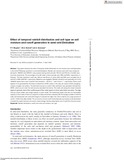Please use this identifier to cite or link to this item:
https://cris.library.msu.ac.zw//handle/11408/4221| Title: | Effect of temporal rainfall distribution and soil type on soil moisture and runoff generation in semi-arid Zimbabwe | Authors: | Mugabe, Francis T. Hodnett, M. G. Senzanje, A. |
Keywords: | Rainfall distribution Semi-arid Soil moisture Soil type |
Issue Date: | 2007 | Publisher: | IWA Publishing | Series/Report no.: | Hydrology Research;Vol. 38; No. 3: p. 249-263 | Abstract: | This paper examines the effect of temporal rainfall distribution on soil moisture and runoff generation in the 5.9 km2 Mutangi catchment in semi-arid Zimbabwe. Rainfall, soil moisture and runoff were measured during the 1999/00 and 2000/01 rainy seasons during which periods 755 mm and 615 mm of rainfall were received, respectively. The percentage of rainfall totals in these periods were 58% and 69%, respectively, in February. The total catchment runoff was 102 mm and 63 mm, of which 52% and 49% were recorded over 6 and 4 d in 2000 and 2001, respectively. Baseflow was negligible. Rainfall intensities were generally low. In the 1999/00 season there were 2 and 8 h with intensities >20 mm h−1 and 10 mm h−1, respectively. Some runoff appears to be generated by Hortonian overland flow (HOF), mainly in the early wet season before ploughing creates a rougher soil surface. The dominant process of runoff in this catchment was saturated overland flow (SOF), which occurs when the soils become saturated from below. The sodic soils along the stream channels appear to generate most of the runoff because of their small capacity to store water before saturation. The ridge soils are coarse sands, with a large capacity to store rainfall. The transitional (slope) soils have an intermediate capacity to store water. If there is a sequence of daily events that completely fills the storage available in both the sodic and transitional soils, and which begins to saturate the ridge soils, there could be very large amounts of runoff (>50% of the daily rainfall). The occurrence of such runoff events depends very heavily on the distribution of rainfall. Dry spells between rain events create storage, thereby reducing the risk of runoff from the next events. | URI: | https://doi.org/10.2166/nh.2007.014 https://iwaponline.com/hr/article/38/3/249/686/Effect-of-temporal-rainfall-distribution-and-soil http://hdl.handle.net/11408/4221 |
ISSN: | 1998-9563 2224-7955 |
| Appears in Collections: | Research Papers |
Show full item record
Page view(s)
174
checked on Jan 14, 2026
Download(s)
38
checked on Jan 14, 2026
Google ScholarTM
Check
Items in MSUIR are protected by copyright, with all rights reserved, unless otherwise indicated.




